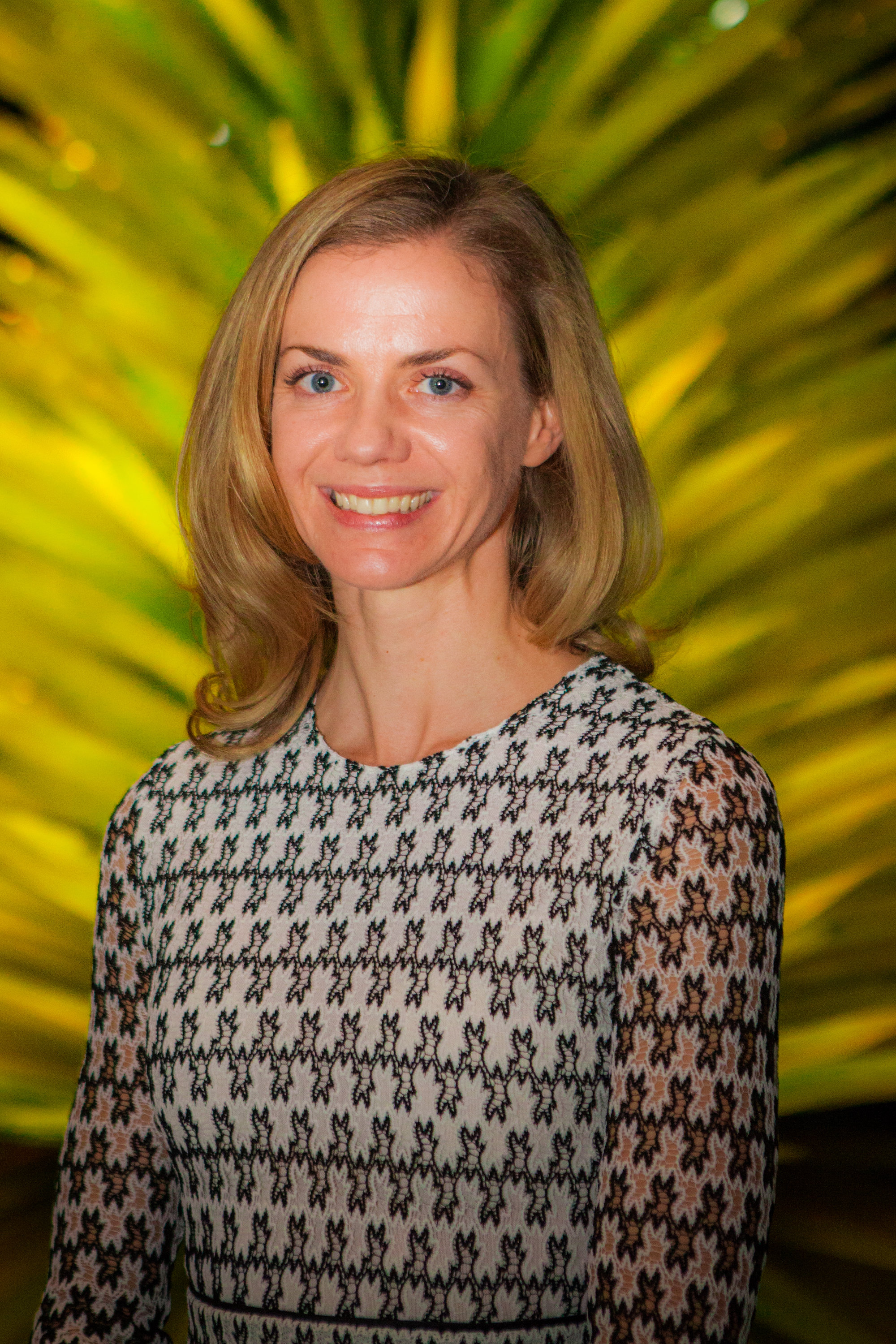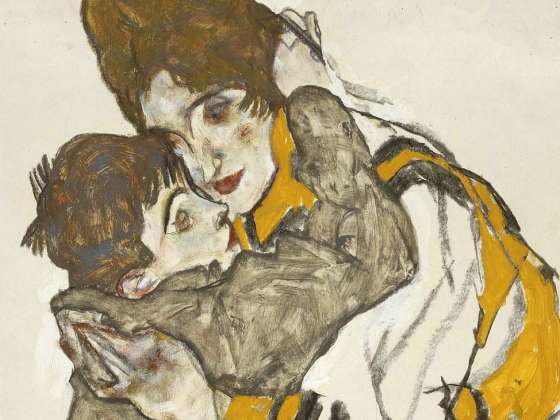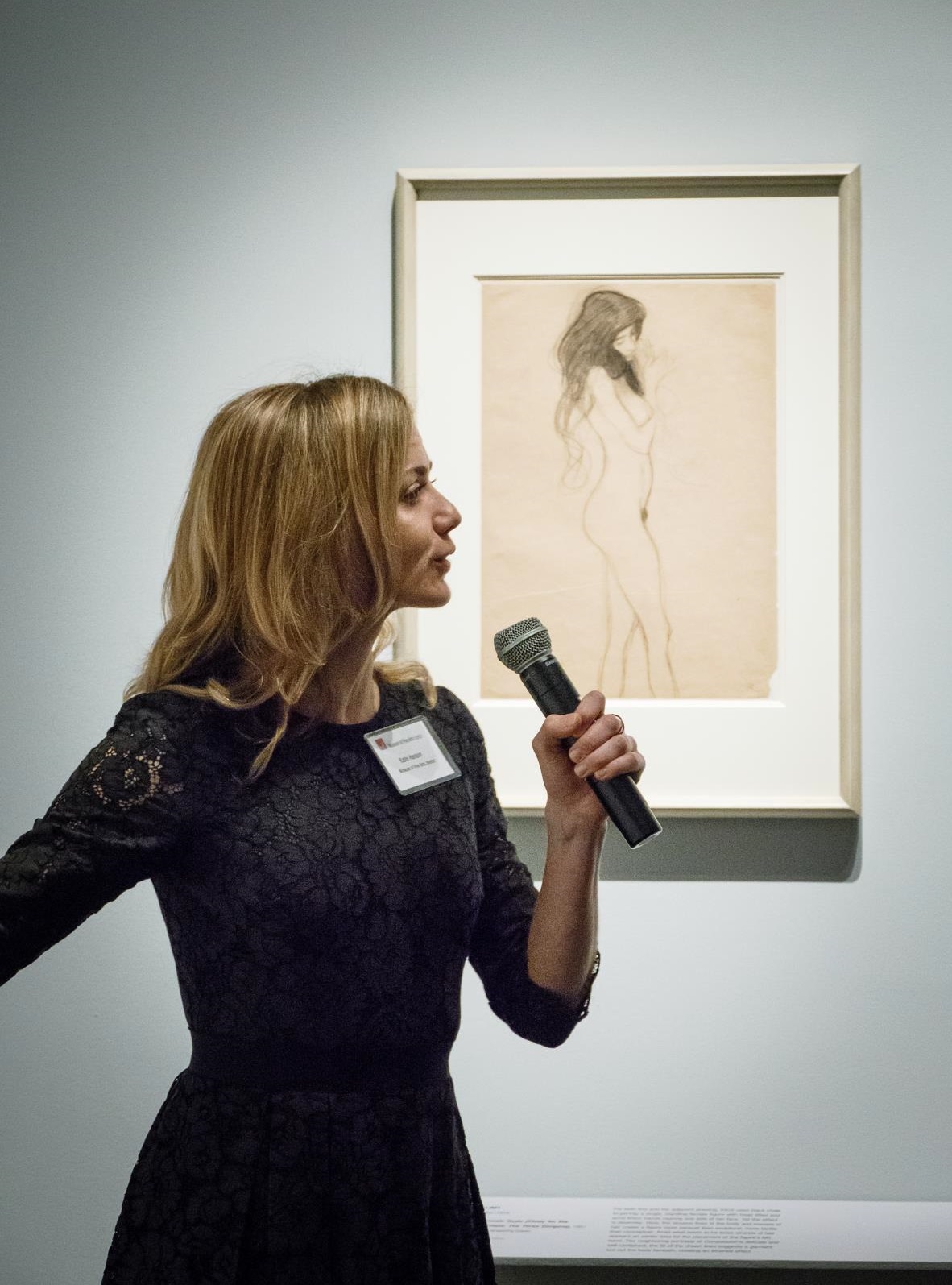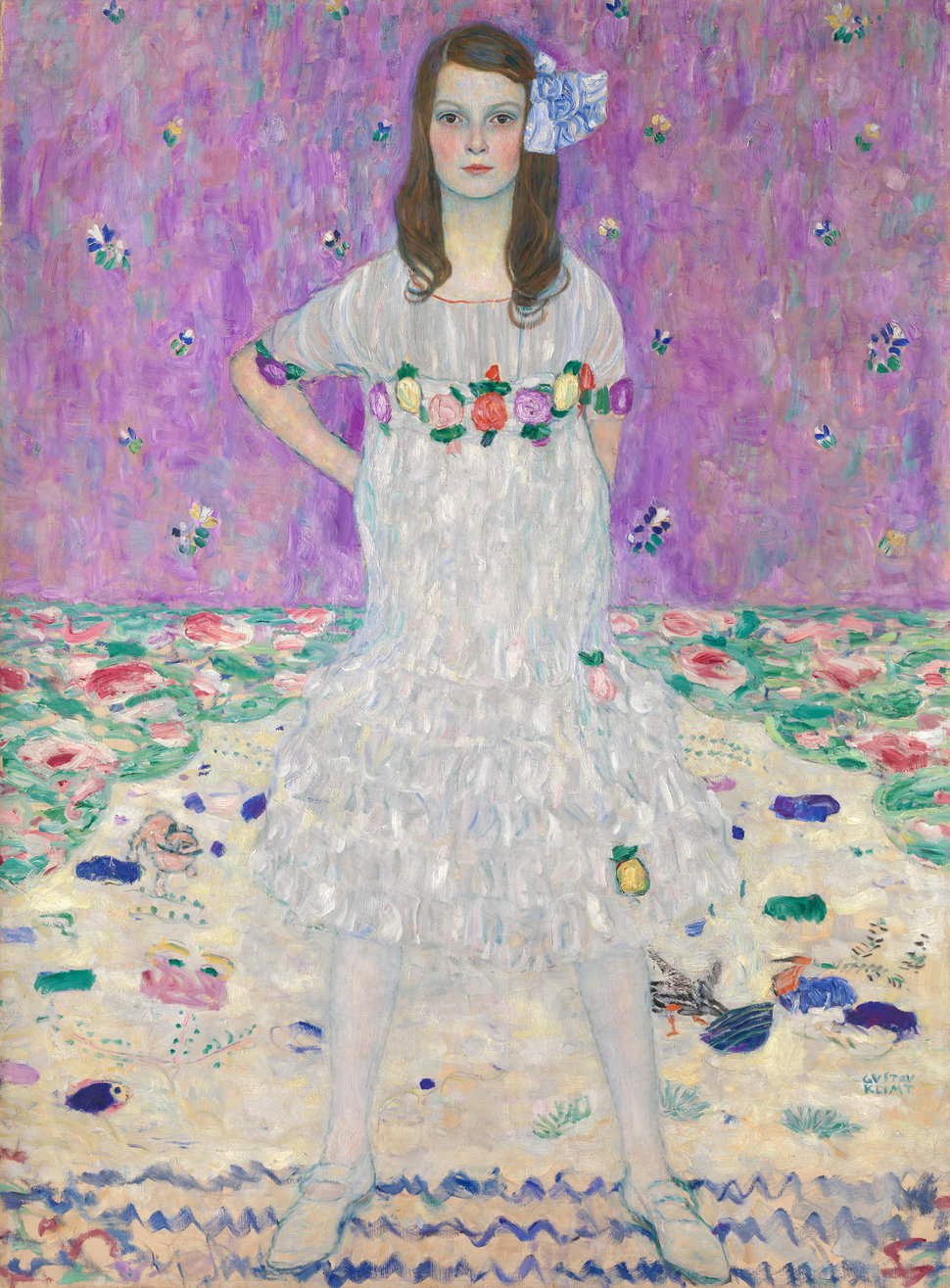 Katie Hanson, Assistant Curator, Paintings, Art of Europe – MFA, Boston
Katie Hanson, Assistant Curator, Paintings, Art of Europe – MFA, Boston
Today I’d like to introduce you to Katie Hanson — Assistant Curator, Paintings, Art of Europe at the MFA Boston. A Wisconsin native, Katie holds an MA from Williams College and a Ph.D. from the Graduate Center of the City University of New York. She has also contributed to various scholarly journals, publications, and exhibition catalogs surrounding the work of artists such as Henri Matisse and Jean-Honoré Fragonard.
Ms. Hanson is currently hosting an exhibit, “Klimt and Schiele: Drawn,” that allows the audience a unique opportunity to view rarely seen drawings by renowned Viennese modernists, Gustav Klimt and Egon Schiele. The show, which will run until May 28th of this year, features a selection of 60 drawings on loan from the Albertina Museum in Vienna. It strives to show viewers, according to Hanson, “the extremes of age and emotion […] the frank naturalism and provocative depictions of the human body for which both are renowned.”
I had the opportunity of speaking with Ms. Hanson for the fourth interview in my “Conversations” series. Read on to learn about her journey in the art world, the thought behind her current exhibit “Klimt, Schiele: Drawn,” and how she is finding a voice for modernism in a contemporary world.

Egon Schiele, Schiele’s Wife with Her Little Nephew (detail), 1915. Charcoal and opaque and transparent watercolor on paper. Edwin E. Jack Fund.
Tell us about your background and the journey that led you to the art world and to a very important curatorial role at the MFA, Boston.
Oh my goodness! Where do I start? Is childhood too far back? I’ve pretty much known that this is what I wanted to do since I was 12. In seventh grade, a brochure arrived in the mail to my parents’ home in Madison, WI offering a trip to Russia for students my age. I had never been abroad, but I loved reading and watching programs on public television about faraway places, so I asked my parents if I could apply and they very generously agreed that I could go if selected. It was this first, formative trip – seeing so much art and architecture, hearing a foreign language, experiencing a wider world – that really motivated me to want to study art, language, and culture. My parents like to joke that they sent an adolescent and got back an aspiring art historian.
I kept pursuing opportunities for student travel throughout high school and studying French. So it was a pretty natural progression of things for me to major in art history and French as an undergraduate at the University of Wisconsin. (I wrote a thesis on Sonia Delaunay’s textile and fashion arts.) I went directly from there to the M.A. program at Williams College, interning at the Clark during the academic year and the Metropolitan Museum of Art during the summer. (I wrote my qualifying paper on Manet.) Then I had a curatorial fellowship in the Drawings Department at the Getty. Lee Hendrix was head of the department then and she was working on a big loan show of Cézanne watercolors with Carol Armstrong, so I was brought on board for that project. I also worked on in-house exhibitions of Baroque drawings with Stephanie Schrader and of four centuries of watercolors with Christine Giviskos (who is now at the Zimmerli).
It was a dream gig, but it was just a one-year fellowship post and everyone who had the actual job I wanted also had a Ph.D., so I headed back to New York to pursue my doctorate at the Graduate Center of City University of New York under the supervision of Patricia Mainardi. I thought I would write about Manet as a draftsman and I ended up writing about amorous and fantastical subjects from Greco-Roman mythology in French Neoclassical painting, but that’s another story for another day. During the seven years it took to complete my doctoral coursework and dissertation, I had a whole bunch of different art world jobs.
I did contemporary art appraisal for Silverman Fine Art, LLC, which was great, great fun. I loved going to clients’ homes or storage facilities to see their collections. I researched Fred Ebb’s bequest of German and Austrian drawings for the Morgan Library. I gave private tours of museums, including one on the theme of loss and recovery for a group of young widows that ended up being featured in several chapters of a book (Saturday Night Widows) one of them wrote! But mostly, I was an adjunct teaching at City College of New York during the academic years and the American University of Paris during the summers. One of the summer courses I taught was “Art through Paris Museums” which is basically a survey of Western Art taught all on location using museums and buildings throughout the city. It was a marvelous way for me to learn the Paris museum collections in depth and I taught it two summers in a row.
After I graduated, I did a curatorial fellowship in Indianapolis, working with Ronda Kasl (who is now at the Met) and then worked as Jodi Hauptman’s curatorial assistant at MoMA for Henri Matisse: The Cut-Outs and Edgar Degas: A Strange New Beauty. After two years at MoMA, I saw the posting for my current job at the MFA. I had a dream that someone else got the job and I was devastated (in my dream), so I applied the next morning and had my first interview within maybe three days…and that was three and a half years ago.
How have you “developed your eye” and sense of aesthetics — is it by viewing many works or is it from more of a scholarly approach?
Looking is essential. Seeing a lot of works. And having the opportunity to look with others – to share observations. One of the great pleasures of being a curator is getting to look with other curators and with conservators, with colleagues outside the museum, and with visitors. Certainly, there’s a scholarly component of learning to look by reading great art historians’ descriptions of what they see and by attending lectures. But being with works firsthand is key. My sense is that you develop an eye by seeing a lot of works, comparing them in your mind against others you have studied.

Katie Hanson at “Klimt, Schiele: Drawn.”
The art world is largely focusing on contemporary works, and museums — to a degree — are following suit. How do you curate shows surrounding 19th century and early 20th century works that resonate with the public?
That’s such a great question! I don’t have a definitive answer, but I am happy to share with you some of the things I think about and try to employ.
One of the things I love about the historical period of focus for my work is that there is a lot of documentation available whether it is in the form of artists’ letters or art criticism from when the works were new. I strive to find ways to bring those words into play in exhibitions and permanent collection galleries to bring the past to life and to give the artists center stage. And to provide cues about looking at the labels. What do I mean? Paul Signac wrote about how to look at paintings like his, so we put that text on the wall next to his work. In essence, he tells the viewer to back up to see the full painting first and then to come closer and look at smaller portions, see how it is made. I observe visitors following his instructions when I pass through that gallery.
In 2016, I had a tiny Picasso exhibition (Pairing Picasso) at the MFA – one gallery with 11 works of art that were grouped into four pairs and a trio. It was an exhibition about creative process and looking. In each grouping, Picasso was treating the same subject (whether it was the same model or the same narrative subject) twice – or three times. The exhibition designer, Kyla Hygysician, had the brilliant idea to build bump-out walls for each set to further reinforce the groupings. It was visually self-evident what to do, how to look, in that space. The texts all began with Picasso’s own voice and reinforced comparative close looking. Asking visitors to engage, to look slowly and thoughtfully, and to bring their own observations.
You and I talked a bit about this with the Klimt and Schiele exhibition and its labels. For me, many of the drawings elicit a strong visceral, emotional response. I wanted the voice in the exhibition, the tone of the label text, to encourage looking and feeling. Finding a balance of context, ways of looking, and an openness to feeling was something I worked on with Adam Tessier, the MFA’s head of interpretation, as a goal for this exhibition and its texts.
These examples are all pointing toward a common thread of trying to create an experience that resonates for the visitor by being open and approachable, by asking for participation (move, look, feel) and leaving space for personal experience.
Your exhibition, “Klimt, Schiele: Drawn,” is currently on display at the MFA, Boston. It’s a wonderful exhibition of 60 works on paper on loan from the Albertina in Vienna (on view until May 28th, 2018). What can we learn through the exhibition about their world, their art, and their friendships?
Thank you. I’m so glad you have enjoyed the exhibition!
Until this year with the centenary of both artists’ deaths, typically Klimt and Schiele have appeared in monographic exhibitions or if together then also with another artist, for example, Kokoschka, or many artists within the larger context of Vienna 1900. So this exhibition presented a special opportunity to focus tightly on just these two artists and on their drawings. The drawings in the exhibition bring out aspects of the larger art world in Vienna at the turn of the last century – the fraught context within which Klimt and Schiele pushed at boundaries and defied expectations in their portrayals of the human body.
The drawings also bring forth relationships – between Klimt and Schiele, between these artists and their models, and between these artists and their patrons, supporters, and critics. In our own age of social networks and art world controversies, I wonder if this kind of focus, which begins with the individual works and teases out compelling relationships and complex controversies germane to those individual works and to the broader context of the time and place they were created, also heightens a sense of understanding of the past, of its networks and scandals as resonant with our own time.
What did you have in mind when curating this exhibition? What kind of conversation did you want to ignite among viewers?
The exhibition marks the centenary of both artists’ death. And even in the full awareness that these drawings were made at least 100 years ago, there is something about their work that still resonates with raw emotion, psychological charge, vulnerable presence. I wanted to shed light on their relationship, on parallels in their careers, but also honor and acknowledge how divergent their work is in appearance. We chart their parallel but separate experiences in the exhibition’s layout, giving space for Klimt’s lyricism and Schiele’s nervy agitation. These artists shared a willingness to explore and give form to life’s less pretty and polished aspects, to instinctual urges, and to their own questioning – of how to see and know other people and themselves. For me, that seeking and searching reaches across a century’s divide.
There’s a review (by Adam Kirsch) of Klimt and Schiele: Drawn in this month’s NY Review of Books and I was so moved by the concluding sentence: “Part of the purpose of exhibitions like ‘Drawn’ is to provide a contained environment in which such dangerous energies can be contemplated without being approved – a distinction upon which rests the very possibility of creating art.” There are a lot of energies in these sheets and I hope the exhibition provides a space to look and think and feel in the presence of the works.

Portrait of Mada Primavesi, 1912. Found in the collection of the Metropolitan Museum of Art, New York. (Photo by Fine Art Images/Heritage Images/Getty Images)
As you know, I have a particular interest in the Mada Primavesi portrait, that hangs at the Met in NYC, (the drawing of which is in your exhibition) — as I knew her and had worked closely with her on the sale of her mother’s portrait at Sotheby’s. How did you respond to the piece given that it was the only commissioned portrait of a child that Klimt painted? How do you feel he approached the subject in ways he may not have with some of his other portraits?
It was important to me that we were able to borrow drawings for the portrait of Mada Primavesi. I knew we would have many drawings by Schiele featuring children and adolescents, so Klimt’s drawings of Mada provided a counterpoint to those, continuing that parallel but separate concept in the exhibition. Both artists approached their portrayals of young people with seriousness, with a compelling consideration of who these people are as individuals.
I looked at many more drawings of Mada Primavesi than the two that are in the exhibition and I was taken with the strong sense of presence conveyed in all of the sheets featuring her. The drawings give the impression that Klimt approached her with the same dignity and seriousness with which he would approach an adult sitter. With some of the portrait drawings of adults, I feel as though I’m seeing a conversation, as though I’m seeing the artist and the sitter interacting, and perhaps in the drawings of Mada there is a bit more distance.
![Eugenia Primavesi. D187. Oil on canvas. 1913/14. (Photo by Imagno/Getty Images) [Bildnis Eugenia Primavesi. D187. oel auf Leinwand. 1913/14]](http://cottinghamfineart.com/wp-content/uploads/2018/05/Eugenia-Primavesi-Gustav-Klimt.jpeg)
Eugenia Primavesi. D187. Oil on canvas. 1913/14. (Photo by Imagno/Getty Images) [Bildnis Eugenia Primavesi. D187. oel auf Leinwand. 1913/14]
What and who inspires you?
Great human achievement inspires me. I run marathons and I find the community of runners and spectators coming together to be incredibly moving. I curate 19th and 20th-century European art and that brings me up close to astonishing works of art, the sensitivity and daring of the creative spirit.
What is good art to you?
For me, the mark of a great work of art is that I see the world differently for having encountered it. It becomes a part of how I see and how I think. Great art continues to live in me.
____
